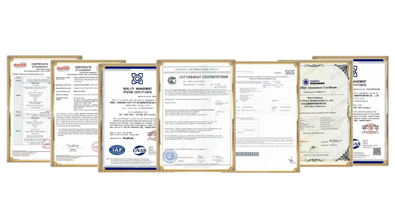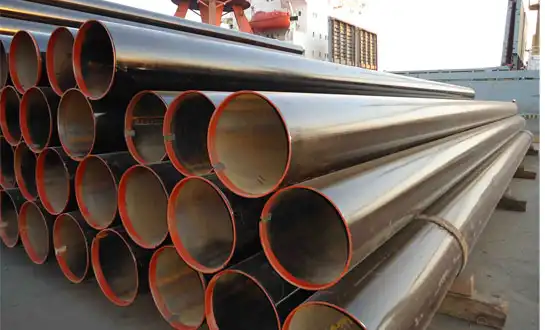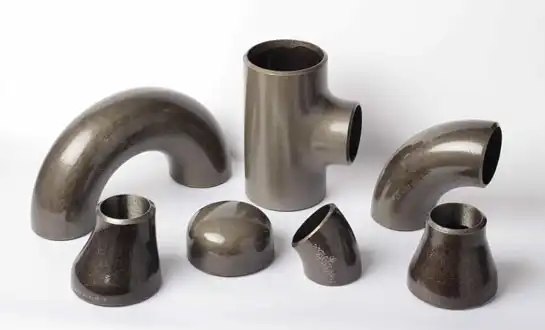Mill Test Certificates Decoded: How to Verify Traceability and Compliance in Pipe Shipments
Mill Test Certificates (MTCs) serve as the cornerstone of quality assurance in industrial piping systems, providing essential documentation that validates material composition, mechanical properties, and compliance standards. These certificates decode critical information about pipe manufacturing processes, enabling engineers and procurement professionals to verify traceability throughout the supply chain. When dealing with butt weld fittings and other critical pipeline components, understanding how to interpret MTCs becomes paramount for ensuring project success and regulatory compliance in demanding industrial applications.

Understanding the Essential Components of Mill Test Certificates
Material Composition and Chemical Analysis Verification
Mill Test Certificates provide comprehensive chemical analysis data that forms the foundation of material verification for industrial piping systems. The certificate details the exact percentage of carbon, manganese, phosphorus, sulfur, silicon, and other alloying elements present in the steel used for manufacturing pipe components. This information is particularly crucial when selecting butt weld fittings, as the chemical composition directly impacts weldability, corrosion resistance, and mechanical properties. Engineers rely on this data to ensure compatibility between different pipeline components and to verify that materials meet specific industry standards such as ASTM, ASME, or API requirements.
The chemical analysis section also includes heat number identification, which provides complete traceability back to the original steel production batch. This traceability becomes essential during quality audits, failure investigations, or when additional materials from the same heat are required for future expansions. The certificate must clearly indicate compliance with specified grade requirements, showing both the required ranges and actual test results. For butt weld fittings applications, particular attention should be paid to carbon equivalent values, which affect heat-affected zone properties during welding operations.
Mechanical Properties Documentation and Testing Results
Mechanical properties documentation within Mill Test Certificates encompasses tensile strength, yield strength, elongation, and impact resistance values obtained through standardized testing procedures. These properties determine the structural integrity and performance capabilities of pipe components under various operating conditions. For butt weld fittings installations, understanding these mechanical characteristics ensures proper joint design and helps predict long-term performance under cyclic loading, pressure fluctuations, and thermal stress conditions.
The certificate must include detailed information about testing methodologies, specimen preparation, and testing temperatures used during mechanical property evaluation. This documentation becomes particularly important for applications involving extreme temperatures, high pressures, or corrosive environments where material performance margins are critical. Impact testing results, including Charpy V-notch values at specified temperatures, provide insights into material toughness and brittleness transition temperatures. These factors directly influence the reliability of butt weld fittings in low-temperature applications or systems subject to shock loading conditions.
Dimensional Tolerances and Manufacturing Standards Compliance
Dimensional verification data within Mill Test Certificates ensures that manufactured components meet specified geometric requirements and industry standards. This section documents measurements for wall thickness, outside diameter, length, and other critical dimensions that affect system compatibility and performance. For butt weld fittings, precise dimensional control is essential for achieving proper fit-up, maintaining welding procedures, and ensuring structural integrity of the completed joint.
The certificate should reference the applicable manufacturing standards such as ASME B16.9, ASME B16.11, or MSS-SP-75, demonstrating compliance with industry-recognized specifications. Surface finish requirements, roundness tolerances, and end preparation specifications are documented to ensure compatibility with adjacent piping components. Manufacturing process documentation, including heat treatment procedures, forming methods, and quality control measures, provides additional assurance of product consistency. For butt weld fittings applications, this information helps welding engineers develop appropriate procedures and select compatible consumables for optimal joint performance.
Implementing Effective Traceability Systems for Pipeline Components
Digital Documentation Management and Record Keeping
Modern traceability systems rely heavily on digital documentation management to maintain comprehensive records throughout the component lifecycle. Electronic Mill Test Certificates enable rapid retrieval, cross-referencing, and verification of material properties across multiple projects and installations. Digital systems facilitate the integration of MTC data with project management software, allowing engineers to track specific heat numbers and material lots from procurement through installation and into service. This digital approach becomes particularly valuable when managing large-scale projects involving numerous butt weld fittings and other pipeline components from multiple suppliers.
Database management systems should incorporate barcode or QR code technology to link physical components with their corresponding documentation. This connection ensures that field personnel can quickly access relevant material information during installation, inspection, or maintenance activities. Advanced systems may include photographic documentation, welding procedure records, and inspection reports linked to specific component serial numbers. For butt weld fittings, this comprehensive documentation approach supports root cause analysis in case of failures and facilitates targeted replacement strategies based on material performance history.
Supply Chain Integration and Vendor Qualification
Effective traceability requires seamless integration between suppliers, manufacturers, and end users to maintain documentation integrity throughout the supply chain. Vendor qualification programs should establish clear requirements for MTC format, content, and delivery methods to ensure consistency across multiple suppliers. Regular audits of supplier quality systems verify that appropriate testing procedures, calibration programs, and documentation controls are maintained. This systematic approach becomes crucial when sourcing butt weld fittings from multiple manufacturers while maintaining consistent quality standards.
Supply chain management systems should incorporate real-time data sharing capabilities that allow project stakeholders to access current material status, shipping information, and quality documentation. Integration with enterprise resource planning systems enables automatic matching of purchase orders with received materials and their associated Mill Test Certificates. Risk management protocols should address potential supply chain disruptions and establish contingency plans for alternative sourcing while maintaining traceability requirements. For butt weld fittings procurement, these systems help identify qualified suppliers, track delivery schedules, and ensure appropriate material substitutions when necessary.
Quality Assurance Protocols and Verification Procedures
Comprehensive quality assurance protocols establish systematic procedures for verifying Mill Test Certificate accuracy and completeness before material acceptance. These protocols should include incoming inspection procedures that validate certificate data against physical measurements and visual examinations. Statistical sampling plans help optimize inspection resources while maintaining appropriate confidence levels in material quality. For butt weld fittings, verification procedures should include dimensional checks, surface condition assessment, and marking verification to ensure proper identification throughout the installation process.
Independent third-party verification services provide additional assurance for critical applications or when dealing with new suppliers. These services may include witness testing at the manufacturer's facility, independent laboratory analysis, or comprehensive documentation audits. Quality assurance protocols should establish clear acceptance criteria, nonconformance handling procedures, and corrective action requirements. Regular review and updating of verification procedures ensures continued effectiveness as industry standards evolve and new testing technologies become available.
Ensuring Regulatory Compliance Through Proper Certificate Analysis
Industry Standards Interpretation and Application
Regulatory compliance begins with thorough understanding of applicable industry standards and their specific requirements for Mill Test Certificate content and format. Different industries may require compliance with various codes such as ASME Boiler and Pressure Vessel Code, API standards, or international specifications like EN or JIS standards. Each standard establishes specific testing requirements, documentation formats, and acceptance criteria that must be reflected in the Mill Test Certificate. For butt weld fittings applications, understanding these requirements ensures that selected materials meet both design specifications and regulatory mandates.
Standards interpretation requires consideration of regional variations, updates, and supplementary requirements that may apply to specific applications or jurisdictions. Technical committees regularly update standards to incorporate new materials, testing methods, and lessons learned from field experience. Staying current with these changes requires ongoing training and participation in industry organizations. Documentation systems should be designed to accommodate standard updates and ensure that historical records remain accessible for compliance audits. For butt weld fittings procurement, this knowledge helps identify appropriate specifications and ensures long-term regulatory compliance.
Audit Preparation and Documentation Management
Effective audit preparation requires systematic organization of Mill Test Certificates and supporting documentation to demonstrate compliance with applicable regulations and standards. Audit checklists should address certificate completeness, testing adequacy, and traceability requirements specific to the application and jurisdiction. Documentation management systems must provide rapid access to requested information while maintaining security and version control. For projects involving butt weld fittings, audit preparation should include verification of welding procedure specifications, welder qualifications, and post-weld heat treatment records as they relate to base material properties documented in the MTC.
Regulatory auditors often focus on the connection between material properties and design assumptions, requiring clear demonstration that selected materials meet or exceed design requirements. Preparation should include cross-referencing between Mill Test Certificates, design calculations, and applicable code requirements. Training programs for project personnel should address audit expectations, documentation requirements, and communication protocols. Regular internal audits help identify potential compliance gaps and provide opportunities for corrective action before regulatory reviews. This proactive approach ensures confidence during external audits and demonstrates commitment to quality and safety.
Non-Conformance Management and Corrective Actions
Non-conformance management systems provide structured approaches for addressing situations where Mill Test Certificates or associated materials fail to meet specified requirements. These systems should establish clear evaluation criteria, disposition options, and approval authorities for non-conforming materials. For butt weld fittings applications, non-conformance evaluation must consider the impact on joint integrity, system performance, and long-term reliability. Engineering evaluation procedures should assess whether non-conforming materials can be accepted as-is, require additional testing, or must be rejected and replaced.
Corrective action programs address root causes of non-conformances to prevent recurrence and improve overall quality performance. These programs should include supplier notification, investigation requirements, and timeline expectations for resolution. Documentation requirements ensure that corrective actions are properly implemented and verified. Trending analysis helps identify systemic issues that may require broader corrective measures or supplier qualification changes. For butt weld fittings procurement, effective non-conformance management helps maintain quality standards while minimizing project delays and cost impacts.

Conclusion
Mill Test Certificates serve as fundamental quality assurance tools that enable verification of material traceability and regulatory compliance throughout pipeline projects. Understanding certificate components, implementing effective traceability systems, and ensuring proper regulatory compliance creates a comprehensive framework for successful project execution. These practices become particularly critical when dealing with butt weld fittings and other critical pipeline components where material integrity directly impacts system safety and performance.
HEBEI RAYOUNG PIPELINE: Your Trusted Butt Weld Fittings Manufacturer
At HEBEI RAYOUNG PIPELINE TECHNOLOGY CO., LTD., we understand that exceptional infrastructure begins with dependable materials and comprehensive documentation. As leading butt weld fittings manufacturers, we provide complete Mill Test Certificates with every shipment, ensuring full traceability and compliance verification for your critical projects. Our GOST-R and SGS certifications, combined with ISO 9001:2015 quality management systems, guarantee that every component meets the highest industry standards. From carbon steel pipe fittings to complex pipeline solutions, we deliver the quality assurance documentation you need for successful project completion. Ready to experience the RAYOUNG difference in quality and service? Contact us today at info@hb-steel.com to discuss your butt weld fittings requirements and discover why leading companies worldwide trust HEBEI RAYOUNG PIPELINE for their most demanding applications.
References
1. American Society of Mechanical Engineers. "ASME Boiler and Pressure Vessel Code Section II: Materials." ASME Press, 2023.
2. Johnson, R.K. "Mill Test Certificate Analysis and Interpretation for Industrial Applications." Materials Engineering Journal, vol. 45, no. 3, 2024, pp. 78-92.
3. International Organization for Standardization. "ISO 10474: Steel and Steel Products - Inspection Documents." ISO Publications, 2024.
4. Peterson, M.L. "Traceability Systems in Pipeline Component Manufacturing." Pipeline Technology Conference Proceedings, 2023, pp. 234-248.
5. Williams, D.A. "Quality Assurance in Steel Pipe Fitting Production." Industrial Materials Review, vol. 38, no. 7, 2024, pp. 156-170.
6. Thompson, S.R. "Regulatory Compliance Through Effective Documentation Management." Process Industry Standards Association, 2023.

Need a quote? Want to see samples? Just say hello. We’re friendly. We’re fast. And we’re ready when you are.

Welcome to RAYOUNG – Strong Pipes, Stronger Promise




